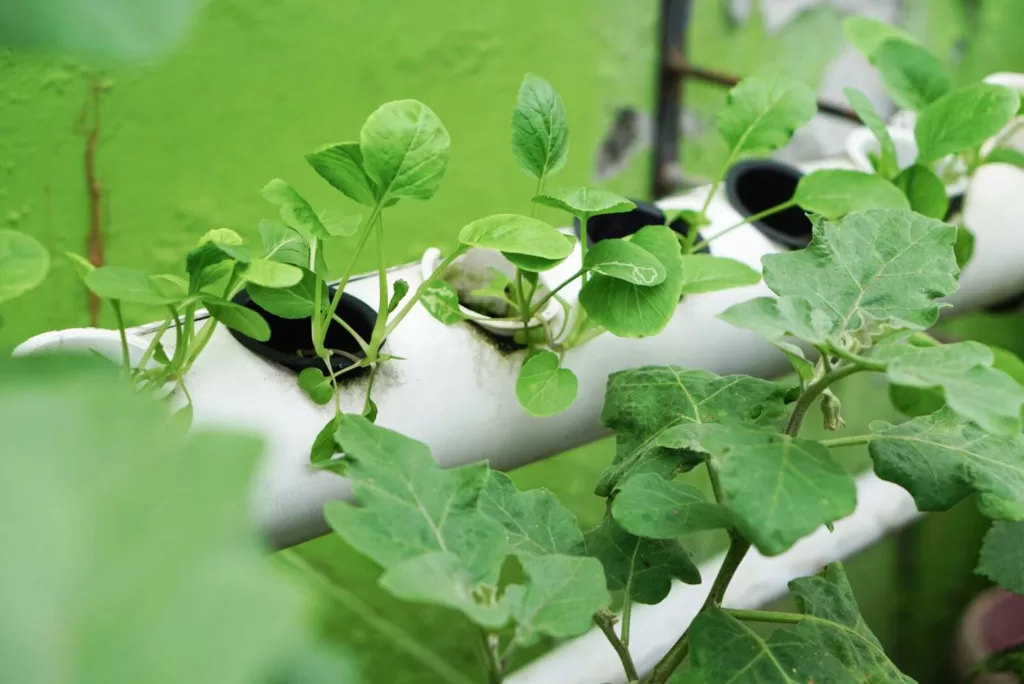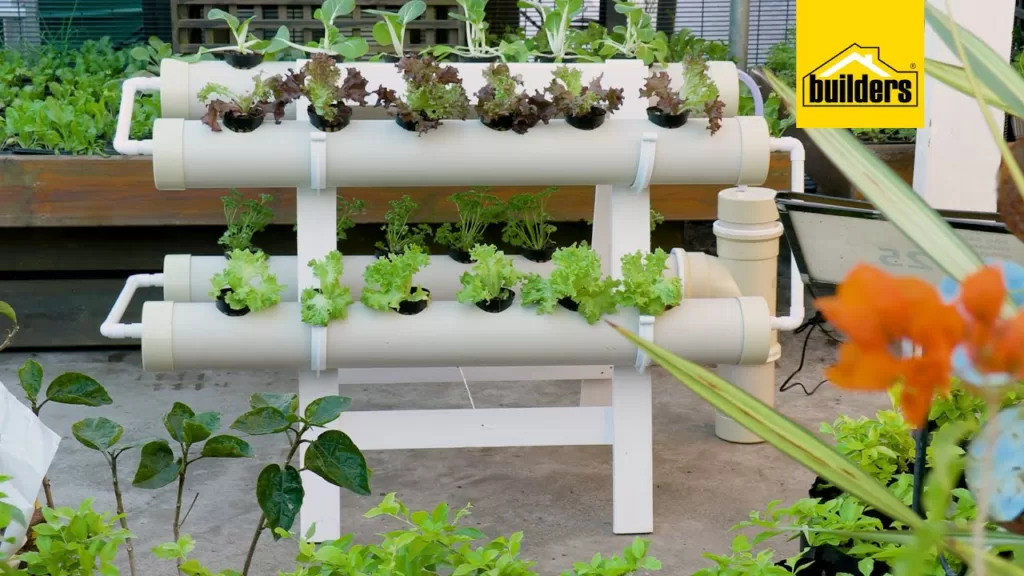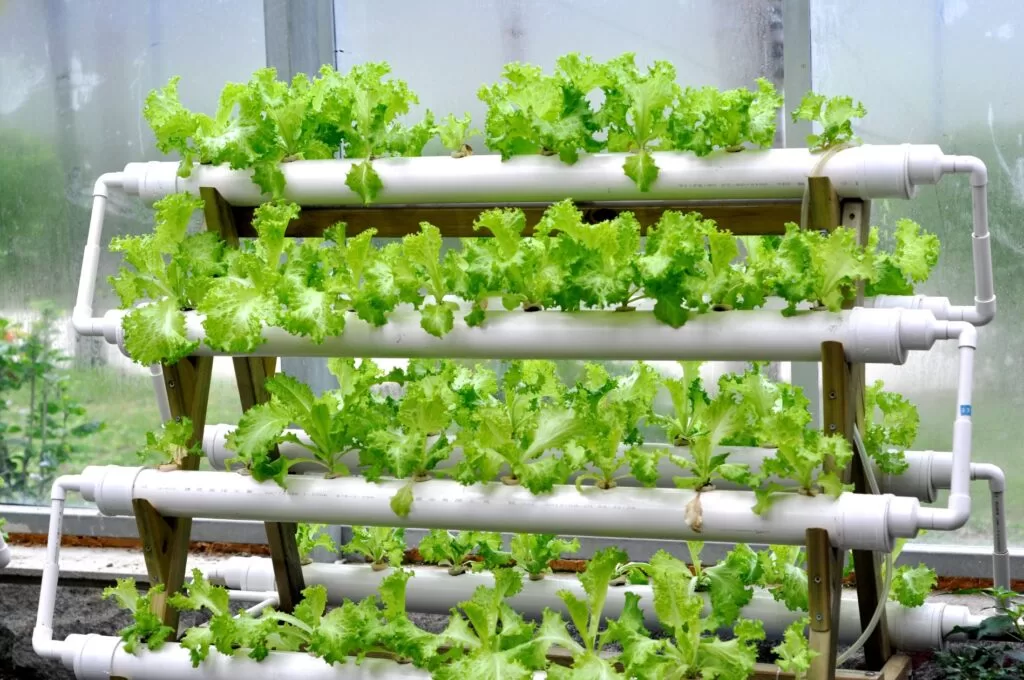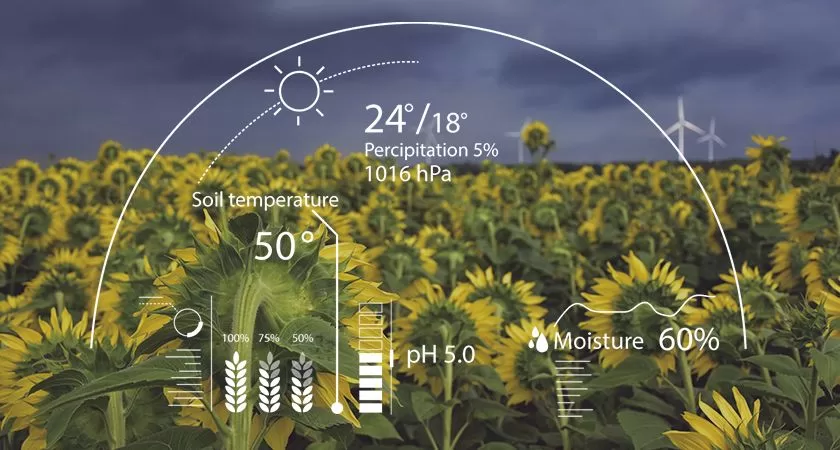Setting up a hydroponic grow system involves several steps:
- Choose a location for your hydroponic system. It should have access to electricity and water and be near a window for sunlight.
- Purchase the necessary equipment, such as a hydroponic grow container, a water pump, tubing, and grow lights.
- Set up the hydroponic container and fill it with a nutrient-rich solution.
- Install the water pump and tubing, ensuring that the water is flowing properly throughout the container.
- Set up the grow lights, making sure they are at the proper height and intensity for your plants.
- Plant your seeds or seedlings into the hydroponic container and make sure they are getting adequate light and water.
- Monitor the temperature, pH, and nutrient levels of the water to ensure optimal growing conditions.
- Regularly check the plants for pests and disease and take appropriate action if necessary.
Note: This is a brief overview, it’s highly recommended to do more research on the different types of hydroponic systems, nutrient solutions, and the specific needs of the plants you are growing.
Table of Contents

What do you need to setup a hydroponic system?
To set up a hydroponic system, you will need the following equipment:
- Hydroponic grow container: This can be a plastic or metal container that holds the plants and nutrient solution.
- Water pump: This is used to circulate the nutrient solution through the container.
- Tubing: This is used to connect the water pump to the container and distribute the nutrient solution to the plants.
- Grow lights: These are used to provide the plants with the light they need to grow, especially if the container is not placed in an area with natural sunlight.
- Nutrient solution: This is a specially formulated mixture of water, minerals, and other nutrients that is used to feed the plants.
- pH and nutrient test kit: These are used to measure the pH and nutrient levels of the water and ensure that the plants are getting the proper balance of nutrients.
- Timer: This is used to control the lighting schedule for the plants.
- Thermometer: This is used to monitor the temperature in the grow area.
- Net cups and clay pebbles or rockwool cubes: These are used to hold the plants in place and to provide a growing medium for the plants’ roots.
- Seeds or seedlings of the plants you plan to grow.
Note: This is a general list and may vary depending on the specific type of hydroponic system you choose to set up.
What are the 6 requirements for hydroponics?
The six basic requirements for hydroponics are:
- Light: Plants need light to carry out photosynthesis, so adequate lighting is crucial for hydroponic growth.
- Nutrients: Hydroponic plants require a specific balance of nutrients, including macronutrients (such as nitrogen, phosphorus, and potassium) and micronutrients (such as iron and zinc), which must be provided in the form of a nutrient solution.
- Water: Hydroponic systems rely on a continuous supply of water to provide the plants with the necessary nutrients and support their growth.
- Temperature: Optimal temperatures vary depending on the plants being grown, but generally range from 60-80F.
- pH: The pH level of the water and nutrient solution must be within a specific range for the plants to be able to properly absorb the nutrients.
- Air: Hydroponic plants require adequate air circulation to promote healthy growth and prevent disease. This can be achieved by using a fan or venting system.
Note: While these are the main requirements, there are other factors to consider such as humidity, CO2, and the type of hydroponic system you are using. It’s important to research the specific requirements for the plants you plan to grow.

How do you grow hydroponically step by step?
Growing hydroponically involves several steps:
- Choose a location for your hydroponic system. It should have access to electricity and water and be near a window for sunlight or have grow lights.
- Purchase the necessary equipment, such as a hydroponic grow container, a water pump, tubing, grow lights, nutrient solution, pH and nutrient test kits, thermometer, net cups, clay pebbles or rockwool cubes, and seeds or seedlings of the plants you plan to grow.
- Set up the hydroponic container and fill it with a nutrient-rich solution. The container can be a simple PVC pipe, a deep water culture, Ebb and flow, drip system, among others.
- Install the water pump and tubing, ensuring that the water is flowing properly throughout the container.
- Set up the grow lights, making sure they are at the proper height and intensity for your plants.
- Plant your seeds or seedlings into the hydroponic container and make sure they are getting adequate light and water.
- Monitor the temperature, pH, and nutrient levels of the water to ensure optimal growing conditions. Use the pH and nutrient test kits to adjust the water and nutrient solution as needed.
- Regularly check the plants for pests and disease and take appropriate action if necessary.
- Harvest your plants when they are ready.
Note: This is a basic overview, it’s highly recommended to do more research on the different types of hydroponic systems, nutrient solutions, and the specific needs of the plants you are growing. It’s also important to have a good monitoring and maintenance schedule.
What is the best hydroponic system for beginners?
The best hydroponic system for beginners is likely the Deep Water Culture (DWC) system. This system is relatively simple to set up and maintain, and it is also one of the most affordable options.
In DWC system, plants are grown in net cups that are placed in a container filled with nutrient-rich water. A water pump is used to circulate the solution, and an air stone is used to provide oxygen to the roots.
This system is easy to use and monitor, and it also works well for a wide variety of plants. It’s also a great option for small spaces, it doesn’t require a lot of room, and it can grow a variety of plants.
Another system that’s also beginner friendly is the Ebb and flow system, it’s a bit more complex than DWC but it’s still easy to maintain, it works by flooding the root zone with nutrient solution, and then letting the solution drain back into the reservoir.
It’s important to note that no matter what system you choose, it’s always important to do proper research and understand the specific needs of the plants you’re growing, and to have a good monitoring and maintenance schedule.
What Cannot be grown hydroponically?
There are a few types of plants that cannot be grown hydroponically, or that are more difficult to grow in a hydroponic system. These include:
- Trees: Trees have deep roots and require a large amount of space, making it difficult to grow them hydroponically.
- Root vegetables: Plants like carrots and potatoes have roots that grow deep into the soil, and they may not be able to grow in hydroponic systems.
- Plants that need wind or pollination: Some plants rely on wind or insects to pollinate, and without these conditions, it can be difficult to get these plants to produce fruit or seed.
- Plants that require a specific soil type: Some plants require certain soil types, like acid-loving plants or those that grow best in sandy soil.
- Plants that require specific weather conditions: Some plants require specific weather conditions to grow, such as certain tropical plants that require high humidity and temperature.
That being said, many plants can be grown hydroponically with proper research and understanding of the specific needs of each plant. With proper research, experimentation and practice, many of these plants that are considered difficult to grow hydroponically can be successfully grown.

How often should hydroponic water be changed?
The frequency of water changes in a hydroponic system will depend on several factors, including the type of hydroponic system, the plants being grown, and the nutrient solution used. In general, it’s important to regularly monitor the nutrient levels in the water and to change the water as needed.
In most hydroponic systems, the water should be changed once a week, or every 5-7 days. This will help prevent the build-up of excess salts and other nutrients that can harm the plants. It’s also important to top up the water as needed to keep the water level consistent.
In some cases, for example, in deep water culture (DWC) systems, the water may need to be changed more frequently, such as every 2-3 days, because the water is in direct contact with the roots and the plants are consuming nutrients at a faster rate.
In other systems such as ebb and flow or drip systems, the water may need to be changed less frequently, such as every 10-14 days.
It’s important to monitor the pH and TDS (Total Dissolved Solids) of the nutrient solution to ensure that the levels are within the optimal range for the plants you are growing. If you notice that the nutrient levels are becoming too high, it’s time to change the water.
It’s also important to remember to clean and sanitize the system before refilling it with fresh water and nutrient solution.
It’s important to note that these are general guidelines, and the specific needs of your plants and system may vary. It’s always important to monitor your plants and water regularly and make adjustments as needed.
What are 3 disadvantages of hydroponics?
- High initial cost: Setting up a hydroponic system can be expensive, as it requires specialized equipment such as grow lights, pumps, and nutrient solutions.
- Power consumption: Hydroponic systems require energy to operate, such as for pumps, lights, and other equipment. This can lead to higher electricity bills, especially for larger systems or for indoor growing operations.
- Dependence on technology: Hydroponic systems rely heavily on technology, such as pumps and timers, to function properly. If any of these components fail, it can lead to crop failure. It also means that a person who is going to run hydroponic system should have enough knowledge and skills to maintain and troubleshoot the system.
- Limited variety of plants: There are some plants that are difficult to grow hydroponically, or that require specific conditions that are difficult to replicate in a hydroponic system.
- Risk of Pest and Disease: as the plants are grown in an enclosed environment, pests and diseases can spread quickly and become difficult to control.
It’s worth noting that all types of agriculture have some disadvantages, but with proper management and maintenance, these can be minimized. And hydroponics also has many advantages such as water and nutrient conservation, high yield, and year-round crop production.
Which fertilizer is best for hydroponics?
There are several types of fertilizers that can be used in hydroponic systems, but the best one for you will depend on the specific needs of your plants and the type of hydroponic system you are using.
- Complete nutrient solutions: These fertilizers contain all of the essential macronutrients (NPK) and micronutrients that plants need to grow and are specifically formulated for hydroponic systems. They are easy to use and provide a balanced and consistent nutrient supply for plants.
- Water-soluble fertilizers: These fertilizers dissolve easily in water and can be used to feed plants in hydroponic systems. They are available in powder or liquid form and are easy to mix with water.
- Organic fertilizers: Organic fertilizers, such as fish emulsion or worm castings, can also be used in hydroponic systems. They are made from natural materials and are a good choice for those who prefer an organic approach to gardening.
- Specialty fertilizers: Some hydroponic systems may require specialized fertilizers for certain plants or growing conditions. For example, some plants require higher levels of certain micronutrients than others.
It’s important to follow the manufacturer’s instructions when using fertilizers and to test the nutrient levels in the water regularly to ensure that they are within the optimal range for the plants you are growing. It’s also important to consider the pH level of the nutrient solution as well, to ensure that it’s within the range suitable for the plants you are growing.
It’s worth noting that there is no one-size-fits-all fertilizer for hydroponics, different types of plants have different needs, and it’s best to research and experiment to find the best fertilizer for your plants and system.

Do I need air pump for hydroponics?
An air pump is not a necessary component of all hydroponic systems, but it can be beneficial in certain types of systems.
Air pumps are typically used to provide oxygen to the roots of plants in hydroponic systems. This is especially important in systems where the roots are submerged in water, such as in deep water culture (DWC) or ebb and flow systems.
In DWC systems, an air pump provides oxygen to the roots which is essential for the plant’s growth. Without oxygen, the plant’s roots will suffocate, and the plant will die.
An air pump can also be used to provide oxygen to the nutrient solution in other hydroponic systems, such as NFT or aeroponics, where the nutrient solution is constantly circulating.
In systems where the roots are not submerged in water, such as drip systems, air pump is not necessary, as the plants will get enough oxygen from the air.
It’s worth noting that there are also other ways to oxygenate the water in hydroponic systems, such as using an air stone, which is a porous stone that can be placed in the water to release bubbles of air, or using a powerhead, which is a device that creates a current in the water to provide oxygen to the roots.
In summary, whether you need an air pump for your hydroponic system will depend on the specific type of system you are using, and the plants you are growing. If you are unsure, it’s best to consult the manufacturer’s instructions or consult an expert for advice.
How do I start hydroponics at home for beginners?
Starting hydroponics at home as a beginner can seem daunting, but with a little research and planning, you can set up a successful system. Here are some steps to help you get started:
- Research different types of hydroponic systems: There are several different types of hydroponic systems, including deep water culture, nutrient film technique, drip systems, and aeroponics. Each has its own advantages and disadvantages, so it’s important to research and choose the one that best suits your needs and experience level.
- Gather necessary equipment: Once you have chosen a system, gather all the necessary equipment, such as grow lights, pumps, tubing, and nutrient solutions. You can purchase hydroponic kits that include all the necessary equipment or purchase the components separately.
- Choose the right plants: Not all plants can be grown hydroponically, so it’s important to choose plants that are well-suited for your chosen system. Some popular plants for beginners include lettuces, herbs, and small fruits like strawberries.
- Prepare the growing area: Set up your hydroponic system in an area that has access to electricity and a water source. Make sure the area is well-ventilated and has adequate lighting.
- Set up your hydroponic system: Follow the instructions that come with your equipment to set up your hydroponic system. This will typically involve assembling the system, filling it with water and nutrient solution, and adding plants.
- Monitor and maintain your system: Once your system is set up, it’s important to monitor and maintain it regularly. This includes checking the pH and nutrient levels of the water, adjusting the lighting and temperature, and keeping an eye out for pests or diseases.
- Experiment and learn: Hydroponics is a field of experimentation and learning, so don’t be afraid to make mistakes and try new things. As you gain more experience and knowledge, you can adjust and improve your system to optimize growth and yield.
Remember that hydroponics is a rewarding, but also a challenging hobby, and it might take some time to get used to it. It’s important to have patience and to be persistent. Reading and educating oneself about hydroponics is also an essential part of this process.







